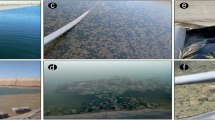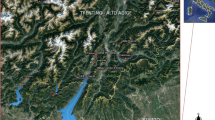Abstract
Bottom and sestonic sediments of Ypacarai Lake were invesetigated with XRF and Mössbauer techniques. The 120 km2 lake, depth averages 1.8 m. In addition to the lakes use for recreation, its basin has economic significance. Sediments play an important role in the distribution of trace elements in the aquatic system and as a sink for metals. Bottom and seston samples were taken from 4 different sampling stations which were selected according the morphology and population sites on the shore. The concentration of toxic metals was found to be low and no adverse ecological impact should be expected. The main metallic ion component is iron (1.68%). Mössbauer studies showed this element appears as Fe3+. Iron2+ was not detected. We suggest that Fe3+ acts as the limiting element which controls the eutrophication process.
Similar content being viewed by others
References
F. S. FACETTI, Rev. Fac. Química y Colegio Químico del Paraguay, 8/9 (1945) 19.
J. F. FACETTI, F. S. FACETTI, Trace Elements in Ypacarai Lake Water (I), in: 5th Interamerican Symp. on the Peaceful Application of Nuclear Energy, O. A. S., Washington D. C., 1965, p. 105.
J. F. FACETTI, F. J. SHADE, Research Report to the Servicio Nacional de Saneamiento Ambiental (unpublished), Asunción, Paraguay, 1978.
J. F. FACETTI, F. J. SCHADE, Research Report to the Municipality of San Bernardino (unpublished), Asunción, Paraguay, 1983.
P. WELCH, Limnological Method, McGraw Hill, New York, 1948, p. 178.
T. A. O'SHEA, K. MANCY, Water Res., 12 (1978) 703.
R. D. GUY, C. L. CHAKRABRTI, Can J. Chem., 54 (1976) 2600.
F. CLARKE, H. WASHINGTON, The Composition of the Earth's Crust, US Geol. Survey, Prof. Paper, 127 (1924).
K. RANKAMA, TH. SAHAMA, Geoquimica (Trad. Castellana), Aguilar, Madrid, 1954.
J. F. FACETTI, unpublished data, 1991.
R. WETZEL, Limnology, 2nd ed., Saunders College Publishing, New York, 1983, p. 261.
J. M. ANDERSON, Arch. Hydrobiol., 76 (1975) 411.
T. FREVERT, Arch. Hydrobiol. Suppl., 55 (1979) 298.
Author information
Authors and Affiliations
Additional information
This is in agreement with low values of phytoplancton counting found in water samples.
Rights and permissions
About this article
Cite this article
Velazquez, R., Alviso, R. & Facetti, J. Sediments of Ypacarai Lake. Journal of Radioanalytical and Nuclear Chemistry, Articles 161, 233–238 (1992). https://doi.org/10.1007/BF02034896
Received:
Issue Date:
DOI: https://doi.org/10.1007/BF02034896




